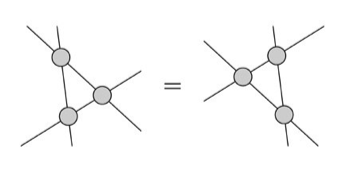Integrable Models
“This belief is handed down in Beersheba: that, suspended in the heavens, there exists another Beersheba, where the city’s most elevated virtues and sentiments are poised, and that if the terrestrial Beersheba will take the celestial one as a model the two tows will become one.”
-- Italo Calvino, Invisible Cities

Integrable structure can appear under several guises and can take several names. For our purposes, integrable systems are synonymous of exactly solvable models and, in particular, we are interested in their quantum applications.The key mathematical properties of all these systems is the Yang-Baxter equation -- an equation that plays a crucial role in the formalism of commuting
transfer matrices, elastic scattering matrices, quantum groups and knot theory.
The theory of exactly solvable models offers a new viewpoint on many interesting (solved and unsolved) problems, in addition to the original scope of studying the dynamics of physical systems in a consistent manner. We may think of many reasons why we are interested in studying exactly solvable models.
Firstly, an exactly solvable model sets a reference system. It serves as a test for computer analysis, for instance; it also gauges analytic methods as perturbation theory or semi-classical methods. Secondly, a nontrivial solvable model reveals an essence of the phenomena under consideration. For instance, the two-dimensional Ising model that may look too simple to be interesting as a model for ferro-magnets has played the most significant role in the establishment of many concepts in critical phenomena; at the same time, it has also helped in disclosing the beautiful mathematical structure of infinite dimensional Lie algebra, the monodromy properties related to Painleve’ equation, and the holomorphic quantum field theory.

Third, solvability brings about a new viewpoint on the nature with novel mathematics: for instance, the “linear” viewpoint based on the Fourier transformation and the superposition principle (introduced originally to solve the heat conduction equation) has governed our way of thinking for about two centuries.
As an additional example, techniques entering the solution of particular exactly solvable systems as, e.g. the lattice statistical models, have rapidly percolated in other fields, linking the quest of physical answers to interesting mathematics such as partition theory, modular
functions and operator algebras and infinite-
dimensional algebraic structures. In this respect, it is worth mentioning the remarkable connection that has been established between two-dimensional statistical models, knot theory, the (2+1) Chern-Simons-Witten topological quantum field theories and the general investigation of particle statistics in two space dimensions: a beautiful theory has been set up to construct link polynomials, topological invariants for knots and links, and various representation of the braid group from the exactly solvable models.
Finding a solvable model is, in general, not a simple task. It requires skill and often depends on luck. Recent research has made it possible however to study a large class of exactly solvable models in a systematic way, although it should be stressed that a general classification scheme is still missing. Particularly important are the results in statistical physics and quantum field theory.
In statistical mechanics, exact solvability of a model means that we can evaluate physical quantities such as the free energy or the expectation values of the order parameters without any approximation. In quantum field theory, solvability implies the exact computation of all correlation functions of local operators or extended objects (as Wilson loops), together with the spectrum of the excitations.
Some Relevant Publications
• G. Mussardo, Statistical Field Theory. An Introduction to Exactly Solved Models of Statistical Physics, Oxford University Press, (Oxford) 2010.
• G. Mussardo, Il Modello di Ising. Introduzione alla teoria dei campi e delle transizioni di fase, Bollati-Boringhieri (Torino), 2007.
• G. Mussardo, Infinite-time average of local fields in an integrable quantum field theory after a quantum quench, Physical Review Letters 111 (10), 100401 (2013)
• D. Fioretto, G. Mussardo, Quantum Quenches in Integrable Field Theories, Journal of Physics 12, 055015 (2010).
• G. Delfino, G. Mussardo, P. Simonetti, The spin-spin correlation function in the two-dimensional Ising model in a magnetic field at T= Tc, Nuclear Physics B 455 (3), 724-758(1995)
• G. Delfino, G. Mussardo, P. Simonetti, Scattering theory and correlation functions in statistical models with a line of defect, Nuclear Physics B 432 (3), 518-550 (1994)
• J.L. Cardy, G. Mussardo, Universal properties of self-avoiding walks from two-dimensional field theory, Nucl. Phys. B .410, 451 (1993), hep-th/9306028
• A. Mossa, G. Mussardo, Analytic properties of the free energy: The Tricritical Ising model, J.Stat.Mech.0803:P03010,2008, arXiv:0706.2546 [hep-th]
• D. Fioravanti, G. Mussardo, P. Simon, Universal Amplitudes Ratios of the Renormalization Group: Two-dimensional Tricritical Ising Model, Phys. Rev. E. 63: 016103 (2001), cond/mat/0008216.
• D. Fioravanti, G. Mussardo, P. Simon, Universal Ratios in 2-D Tricritical Ising Model, Phys. Rev. Lett. 85: 126-130 (2000), 63: 016103 (2001), hep-th/0002225
• F. Colomo, A. Koubek, G. Mussardo, The sub-leading magnetization deformation of the Tricritical Ising Model in 2-D as RSOS restriction of the Izergin-Korepin model, Phys. Lett. B 274: 367-373 (1992), hep-th/9203003.
• J. L. Cardy, G. Mussardo, S matrix of Yang-Lee singulariy in two dimensions, Phys. Lett. B 225, 275-278 (1989)
• G. Mussardo, Off-critical statistical models: factorized scattering theories and bootstrap program, Physics Reports 218 (5-6), 215-379 (1989)
• P. Christe, G. Mussardo, Integrable systems away from critically: The Toda field theory and S-matrix of the tricritical Ising model, Nuclear Physics B 330 (2-3), 465-487 (1990).
• P. Christe, G. Mussardo, Elastic S-matrices in (1+ 1) dimensions and Toda field theories, International Journal of Modern Physics A 5 (24), 4581-4627 (1990)
Main References
• R. J. Baxter, Exactly Solved Models in Statistical Mechanics, Academic Press, 1982.
• B. Sutherlard, Beautiful Models, World Scientific (Singapore) , 2005.
• C. Gomez, M. Ruiz-Altaba, G. Sierra, Quantum Groups in Two-dimensional Physics, Cambridge University Press 1966.
• V. E. Korepin, N.M. Bogoliubov, A.G. Izergin, Quantum Inverse Scattering Method and Correlation Functions, Cambridge University Press 1993